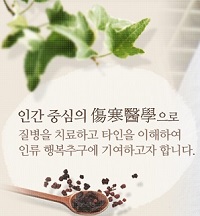『傷寒論』 辨病診斷體系에 근거하여 五笭散 투여 후 호전된 미주신경성 실신 증례 보고 1례
A Case Report of Vasovagal Syncope Treated by Oryeong-san Based on Shanghanlun Provisions
이성준 (정인한의원)
Abstract
- keywords
- Oryeong-san, Vasovagal Syncope, Shanghanlun, Greater Yang disease
참고문헌
1.Kapoor WN. Evaluation and outcome of patients with syncope. Medicine. 1990;69:160-175.
2.Ganzeboom KS, Mairuhu G, Reitsma JB, Linzer M, Wieling W, Van Dijk N. Lifetime cumulative incidence of syncope in the general population: a study of 549 Dutch subjects aged 35-60 years. J Cardiovasc Electrophysiol. 2006;17:1172-6.
3.Ruwald MH, Hansen ML, Lamberts M, Hansen CM, Højgaard MV, Køber L, Torp-Pedersen C, Hansen J, Gislason GH. The Relation between age, sex, comorbidity and pharmacotherapy and the risk of syncope: a Danish nationwide study. Europace. 2012;14:1506-14.
4.The task force for the diagnosis and management of syncope of the European society of cardiology: European heart rhythm association. Guidelines for the diagnosis and management of syncope. Eur Heart J. 2009;30:2631-71.
5.Sutton R, Brignole M, Menozzi C, Raviele A, Alboni P, Giani P, Moya A. Dual-chamber pacing in the treatment of neurally mediated tilt-positive cardioinhibitory syncope. pacemaker versus no therapy: a multicenter randomized study. The vasovagal syncope international study investigators. Circulation. 2000;102(3):294-9.
6.Lee SI. Comparison of Shanghanlun. Seoul: KMediACS publishing house. 2015:24,28,203.
7.Ryu HC, Keack JJ, Choi CW, Lee KN, Lee YS, Kim HC. The study of literature review on the pathological mechanism and therapeutic methods of sudden coma-focused different of opinion of successive dynastic medical group in HwangJeNaeKyung and SangHanRon. The Korean journal of oriental medical precription. 2003;11(1):57-90
8.Neuropsychiatry of College of Korean Medicine. Oriental Neuropsychiatry. Seoul. Jipmoondang. 2012:342
9.Jang JW, Roh HJ, Hong JS, Bae YC, Kim DJ. A clinical case study of vasovagal syncope. Journal of korean oriental internal medicine. 2017;38(2):240-5.
10.Park JK. A case report of primary insomnia treated by Oreyong-san decoction. The journal of KMediACS. 2015;7(1):45-52.
11.Heo J. A case report of dysmenorrhea treated by Oreong-san based on Shanghanlun provisions. The journal of KMediACS. 2014;6(1):63-70.
12.Park JK. Research about application of Shanghanlun disease pattern identification diagnostic system to 2 cases treated by Oreong-san. The journal of KMediACS. 2018;10(1):81-94.
13.Park SY. A case report of hyperhidrosis treated by Oryeong-san based on Shanghanlun provisions. The Journal of KMediACS. 2018;10(1):133-42.
14.Lee SI. A philological research on the way of medical study of ShangHanLun. Herbal formula science. 2014;22(2):1-13.
15.Lee SJ, Lim JE. A diagnostic system and clinical application based on <Shanghanlun> six meridian patterns and provisions. KMediACs publishing house. 2013.
16.Ha YS . Dictionary of chinese etymology. Doseochulpan3. 2014:15,325,337,849.
- 다운로드 수
- 조회수
- 0KCI 피인용수
- 0WOS 피인용수


